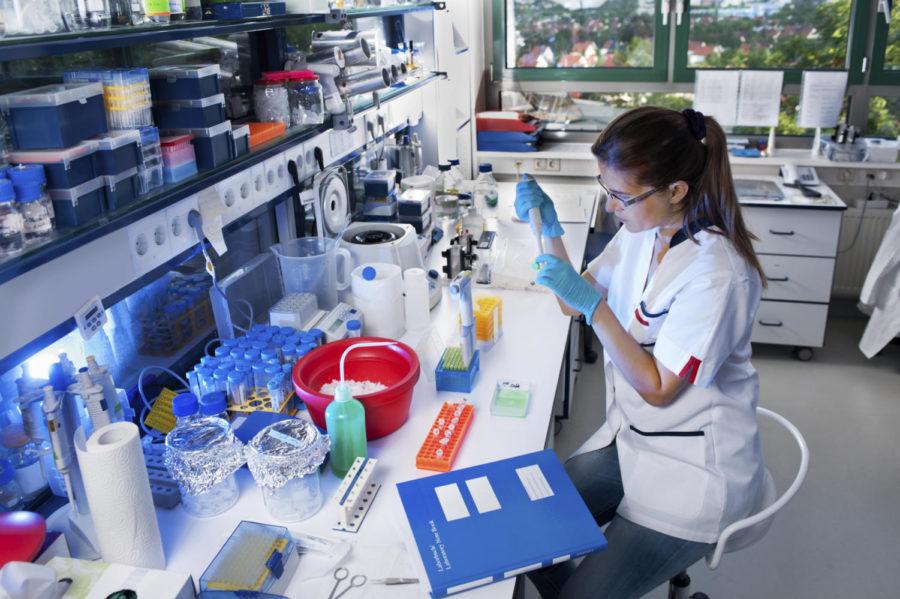Woods: Egg donation needs revision
February 11, 2015
The female body is a remarkable system. It is capable of many feats. The production of eggs may not be as profound an action as giving birth, but it is an integral part of the female reproductive system. These eggs, precious and unique, have a specific purpose to produce children. However, eggs are being used for purposes besides those of which it was intended. Instead of the warm, nurturing comfort of the female body, some eggs are subject to the cold, hard hands of science.
Yet, there are still reasons to be grateful for stem cell research through means other than harvesting eggs. There are possibilities for the alleviation and even the curing of many degenerative diseases. The serious questions that surface about the harvesting of eggs for stem cell research are whether these studies are not only safe for the donor but whether it should be ethically acceptable.
There are some who would believe that the human embryo from the one-cell stage onward has absolute moral value, equal to that of a newborn baby or an adult, any embryo research is ethically unacceptable, as it is tantamount to murder (McLaren 2001).
As it is, stem cell research on female eggs go beyond the ethical issues. For female donors, serious risk and the possibility of harm becomes apparent. The procedure to harvest the eggs is a harsh and strenuous task.
According to Stanford University, “The egg donation process consists of two phases. In the first phase, ovarian hyperstimulation, donors receive a series of hormonal drugs that cause the ovaries to produce multiple mature eggs during one menstrual cycle. During the second phase, egg retrieval, mature eggs are removed from the donor through a surgical procedure called transvaginal ultrasound aspiration. Egg donors should expect to spend around 60 hours for screening, testing and medical appointments throughout the course of the procedure.”
It is in these two phases that the female body experiences danger that can be irreversible. The harvesting of multiple eggs is an invasive, uncomfortable and unnatural process. Both stages, ovarian suppression and what is known as ‘ovarian stimulation,’ require the use of powerful hormones and other drugs to manipulate a woman’s body into producing many, often a dozen or more, eggs at a time rather than the normal one or two (Besson 2006).
It is clear that the unnatural use of hormones in order to produce the coveted eggs are not carefully taken into account as to how they would interact with the female’s body. There are many short-term effects that could occur. However, there is insufficient data to determine what the long-term effects can be.
The most immediate serious risk from ovarian stimulation is ovarian hyperstimulation syndrome (OHSS). Symptoms of mild forms of OHSS include nausea, vomiting, diarrhea and abdominal distention. These symptoms may continue and even worsen through time. Such symptoms include rapid weight gain, accumulation of serous fluid in the spaces between tissues and organs in the pleural and abdominal cavities, respiratory difficulty and other abnormalities (ASRM 2005).
The matter then lies with the participants. How are there volunteers for this risky and harmful procedure? There may be a lack of communication between doctor and patient, or even the downplay of the potential risks to the body. That of course is speculation and can’t be proved. But there is the matter of compensation. Participants can receive between $5,000 and $10,000 for their donation — that could be motivation enough to go through the surgery.
However, regardless of the amount of money paid, it doesn’t detract from the dangers that the hormonal drugs pose. One drug that is commonly used in the first phase of egg harvesting, Lupron — leuprolide acetate — has not been approved for those purposes, but rather is used “off-label.” Another drug, Antagon, has been approved for such use, but no data is available on its long-term safety. The FDA currently has more than 6,000 complaints on file regarding Lupron, including 25 reported deaths (Besson 2006).
With all of the evidence presented, the fact that many clinical reports associate infertility treatment with ovarian cancer and two major studies suggest a link between ovarian cancer and ovarian stimulation (Besson 2006), puts it over the top. How much more harm can be done besides causing infertility? Are the risks not greater than the benefits?
With what we know to be true about the procedure imposed on women to harvest their eggs we can surmise that it isn’t as safe as we would like it to be in order to justify it’s use for stem cell research. More precautions must be taken and more information must be found concerning the effects of the hormones used. The uncertainties surrounding this procedure must be solved before more women are subjected to its dangers.

















